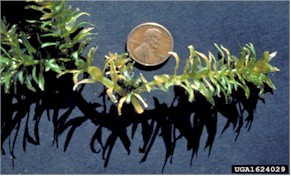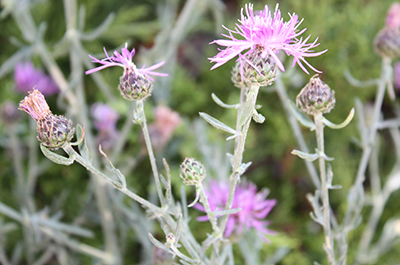Hydrilla
Hydrilla verticillata (L. f.) Royle
Keys to Identification
- Hydrilla is an aquatic weed that has the potential of impacting our waterways and agricultural water supplies. Hydrilla has not yet been found in Colorado.
Family
Tape grass (Hydrocharitaceae)
Other Names
Waterthyme, Florida elodea
USDA Code
HYVE3
Legal Status
Colorado Noxious Weed List A
New in Colorado – call your county weed supervisor if you find this plant!
Identification
Lifecycle
Perennial aquatic
Growth form
Forb/herb
Flower
Female flowers tiny and white, with 6 petals. Male flowers tiny greenish, closely attached to the leaf axle.
Seeds/Fruit
Yellowish turions (“potato-like” tubers). Can remain viable for 4 years.
Leaves
Leaves are small, pointed and arraigned in whorls of 4-8 along the stem. Leaf margins are distinctly saw toothed.
Stems
Submersed stems are long and slender that branch profusely at the water surface. Stem fragments are one means of reproduction.
Roots
Roots in the hydro soil, adventurous roots are white.
Seedling
This plant is noticeable rough when pulled through the hand. Southern populations (US) overwinter as perennials; northern populations overwinter and regrow from tubers.
Similar Species
Exotics
Egaria densa
Natives
Elodea canadensis
Impacts
Agricultural
Could severely impact the Colorado’s system of water delivery (irrigation ditches and canals).
Ecological
Can grow in natural water bodies displacing native plants.
Other
In the South hydrilla impacts the recreational use of water bodies for boating, fishing and swimming. Major infestations limit sport fish size and weight.
Habitat and Distribution
General requirements
Aquatic plant. In Russia hydrilla grows as far north as 50° N Latitude (the equivalent of the USA/Canadian Border).
Distribution
Arizona, Atlantic Coast States to Connecticut (Excluding; New Jersey and New York), California, Gulf Coast States and Tennessee. No infestations of this plant have been documented in Colorado.
Historical
Dioecious type native to India, monoecious plants native to Korea. Believed to have been brought to Florida in the 1950’s for use as an aquarium plant.
Biology/Ecology
Life cycle
Perennial
Mode of reproduction
Mainly plant fragments and turions (vegetative structures).
Seed production
Minimal
Seed bank
Unknown
Dispersal
Water movement, animals, man, recreation, equipment.
References
Aquatic, Wetland and Invasive Plant
Particulars and Photographs
University of Florida, Center for Aquatic and Invasive Plants
http://aquat1.ifas.ufl.edu/hyvepic.html
Non-Native Invasive Aquatic Plants in the United States
Center for Aquatic and Invasive Plants, University of Florida and Sea Grant
http://plants.ifas.ufl.edu/seagrant/hydver2.html


